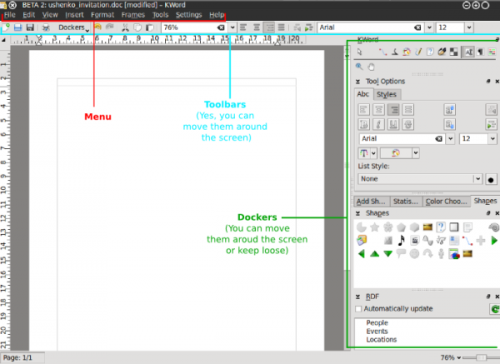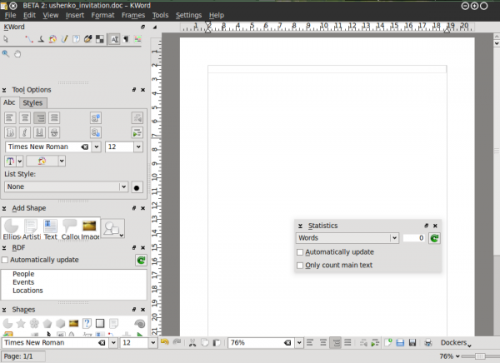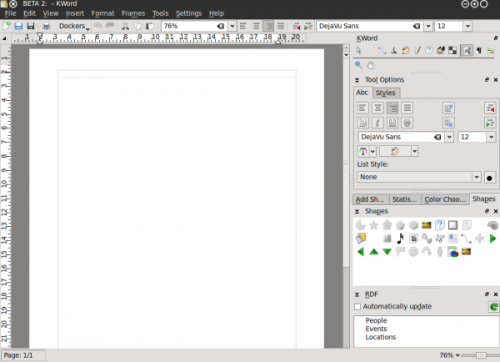KWord/Підручник/Вступні зауваження щодо графічного інтерфейсу
Вступ до графічного інтерфейсу користувача KWord
БЕЗ ПАНІКИ!
Графічний інтерфейс KWord (а також інтерфейс всіх програм KOffice) є гнучким, простим і придатним до розширення одночасно. Такий інтерфейс відбиває ідею глибокої інтеграції різних програм офісного комплексу, а також модульну структуру KOffice та KWord, як однієї з його частин.
Основні частини графічного інтерфейсу KWord

Як можна бачити з наведеного вище зображення, основними частинами графічного інтерфейса KWord є:
- Меню
- Бічні панелі
- Панелі інструментів
Меню завжди перебуває у вікні програми на одному місці, а бічні панелі і панелі інструментів є динамічними елементами графічного інтерфейсу KWord, які можна розташовувати довільно, групувати та прив’язувати до будь-якого з чотирьох країв вікна. Таким чином, ви можете побудувати потрібний вам інтерфейс, без обмеження ваших можливостей кимось, хто вважає, що знає краще за вас, як ви звикли працювати з текстом.
Гнучкість графічного інтерфейсу Kword надає вам змогу змінити вигляд вашого текстового процесора, скажімо, так:

Такий підхід до побудови інтерфейсу надає змогу, наприклад, використовувати KWord, якщо ваша панель KDE розгортається з правого боку екрана у разі наведення вказівника миші на правий край екрана. Якщо ваш робочий простір налаштовано саме так, у вас можуть виникнути проблеми з доступом до бічних панелей.
Menus
Menus are Your terra firma (firm ground under Your feet) of the KWord GUI - all the applications' functions are accessible from there and menus are always visible to the user. In some cases the user may find it to be the most convenient way to use menus only (very small screen estate), but usually they are used in combination with dockers and toolbars.
Most users prefer to use dockers and toolbars as a quick visual access for the functions they use frequently and go to the menu for less used functions. For example, making text bold or italic or selecting font is in most cases more frequently used then say, the frameset properties and it makes more sense to access the latter from the menu.
Toolbars
Oooh, these mighty KWord toolbars ![]()
Dockers
KWord interface, as well as the interface of any KOffice application is built around the concept of Dockers. A Docker is, essentially a KOffice GUI widget that unites certain related functions. For example, "color chooser" docker allows user to choose a color of editable object, "Add Shape" docker allows user to add different shapes (text, images, etc) to their KWord document.
Every docker allows for certain editing functionality in KWord. Since the dockers can be easily turned on and off, grouped, they allow the GUI to be set up so that only the functions the user actually uses/needs are visible in KWord GUI.

Using Menus
Using Toolbars
Using Dockers
List of KWord dockers
- Toolbox
- Tool Options
- RDF
- Add shape
- Statistics
- Color chooser
- Shapes
- Scripts
- Shape properties
- Shadow properties
Governing dockers (turning on and off)
Of course, each user has different requirements of the word processing tool. Especially when the tool is that versatile as KWord is.
A nice example of that is its RDF functions. This is used, for example, to integrate someone's contacts into your document, so that when they are changed, say in your addressbook they are changed in your document. A cool feature, right? Sure, but some people do not need it at all. They are happy with typing and making letters big/small and bold/regular.
We easily came to a conclusion that not really everybody needs to have all the dockers in their KWord interface. It is always better to have some more free space for some other dockers.
Since dockers reflect the modularity of KOffice and KWord their number is constantly growing as is the number of tools and plugins which are available for KWord. And this is the very point where we understand that we need to manage them somehow. Especially if You have a not-so-new notebook with limited screen width.
So, how can You get dockers located on screen in order that is good for you?
Simple:
- Switch off the unnecessary dockers
- Switch on the needed ones (yes, those you personally need, not those someone said must be in a word processor)
- Change the screen edge to suit the way you work
- Make dockers independent
- Group them (probably the most important)
THE DOCKERS CAN BE HIDDEN BY PRESSING Ctrl + H, starting from KOffice 2.3
